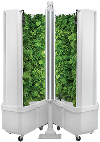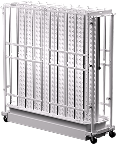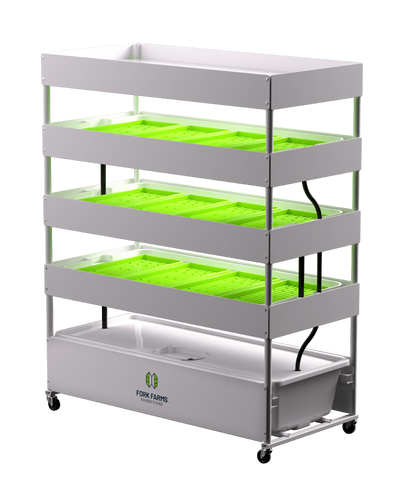4 Steps to Finding the Perfect Indoor Hydroponic Growing System
While hydroponics is relatively new in the food-growing industry, the approach itself isn’t new. William Frederick Gericke, a plant nutritionist at the University of California, is considered a “pioneer” of hydroponic agriculture; he is known for coming up with the word "hydroponics." Publishing “The Complete Guide To Soilless Gardening” in 1940, Gericke was interested in finding an economic solution for hunger.
Hydroponics can also be traced back to The Hanging Gardens of Babylon and the Aztec Floating Gardens, showing how the process worked for ancient civilizations. Perfected over thousands of years, hydroponics growing has stood the test of time, and even today, the approach is simple and practical.
How an Indoor Hydroponics Growing System Works
Hydroponics uses a water-based solution instead of soil to grow plants in horizontal and vertical gardens. The roots feed off a nutrient and water solution, and as many systems are suitable for indoor and outdoor use, hydroponic growing systems are also suitable for use in all environments. Whether you’re an educator, food service professional, or farmer experimenting with a different way of growing produce, indoor hydroponics is exciting and environmentally friendly.
How to Find Your Perfect Indoor Hydroponics Growing System
While hydroponics can have a lot of benefits, it’s essential to understand your personal goals for a growing system. What are you trying to achieve with your hydroponic program? What would it take to get there? For example, some hydroponic growers produce for food service use, while others have goals related to commercial farming or educational purposes. Other considerations, especially when determining the right sized unit, are how much fresh produce you want and the variety. If you’re looking for a system that can grow year-round and work within various spaces, an indoor hydroponics growing system may be your best resource.
Here are a few other considerations when finding the perfect indoor hydroponics growing system.
1. Budget Considerations
There are various hydroponic systems on the market across multiple pricing tiers. There are a range of prices, but they can cost as little as $50 for a small and simple unit to up to thousands of dollars for something more expansive. Your chosen system should be based on your needs and the quality of greens you want to produce. While a cheaper system may be a quick and fast purchase up-front, something more reliable can provide better yield in the long run. When purchasing, you should also consider ongoing costs such as maintenance and consumables.
Educators looking to incorporate a hydroponic system into their school or classroom can also look to funding opportunities through the USDA Farm to School.
2. Space & Infrastructure Requirements
The space requirements and availability are other important considerations for selecting an indoor hydroponics growing system. Are you reusing an existing space, retrofitting it, or finding/buying something new? What are the requirements of the infrastructure, in terms of water and electricity? Will you need to work with the facilities team to upgrade space for the farm?
This is also where the system you choose will vary based on intent. Do you plan on using it for commercial, personal, or educational purposes? All of these factors will matter when you’re using an indoor hydroponics growing system daily.
3. Maintenance and Ease of Use
The time commitment for system upkeep is essential when choosing between systems, especially if you have less experience with growing systems. For beginners, user-friendliness is critical, so selecting a hydroponic company with plenty of resources is important. When purchasing an indoor hydroponics growing system, look for a company that offers growing videos and guides and a good customer and support team. Additionally, many companies have warranty availability and technical teams to help with product issues, offering you another layer of protection (and peace of mind).
4. Environmental Considerations
There is also the sustainability aspect of hydroponics. Compared to traditional forms of farming, hydroponics are more efficient, use less water, and overall, don’t make as large of an environmental impact. Traditional or conventional farming, however, uses resources such as irrigation water, fertilizer, and pesticides.
In time, this can save you a lot of energy and water costs. For environmentally-conscious types, this will be a positive step towards living a more sustainable lifestyle.
Fork Farms and Our Unique Tech & Features
Our Flex Farm system could solve your needs. Our aim is to provide access to sustainable produce for your community through indoor hydroponic farming. We’re passionate about sustainable farming and believe that you should own where your food comes from.
Our partnership model, including educators, nonprofit leaders, food service professionals, chefs, entrepreneurs, and healthcare providers, transforms how people grow and connect with fresh food, leading to impactful and sustainable change. With us, you can discover the power of hyperlocal fresh food and join a connected and motivated community of growers.
Our technology also sets us apart from other farming methods and allows anyone to produce more food per square foot at a lower operating cost.
The design of our indoor hydroponics growing system is efficient, creating the most impact in a more compact space and with a more economical investment up-front.
Investing in an Indoor Hydroponics Growing System
Aspiring growers should focus on their personal goals when choosing a hydroponics system. The next step is to research various options, including our Flex Farm system, and make the choice that aligns best with your unique budget, needs, special considerations, and, ultimately goals.
Next Steps - Is the Flex Farm right for you?
Connect with an expert member of our team and let’s work together to bring your growing experience to life.
Important Links:
























